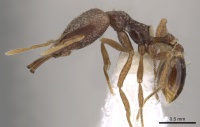Strumigenys dysanetes
| Strumigenys dysanetes | |
|---|---|

| |
| Scientific classification | |
| Kingdom: | Animalia |
| Phylum: | Arthropoda |
| Class: | Insecta |
| Order: | Hymenoptera |
| Family: | Formicidae |
| Subfamily: | Myrmicinae |
| Tribe: | Attini |
| Genus: | Strumigenys |
| Species: | S. dysanetes |
| Binomial name | |
| Strumigenys dysanetes Bolton, 2000 | |
Known from rainforest litter samples.
Identification
Bolton (2000) - A member of the Strumigenys mayri-group. Among the four species which lack a preapical mandibular tooth dysanetes is immediately isolated by its short mandibles and scapes. In dysanetes the indices are MI 38-41, SI 77-83, as opposed to a range of MI 44-51, SI 88-104 in Strumigenys anetes, Strumigenys orthanetes and Strumigenys paranetes combined. Other characters that differentiate these three from dysanetes include the propodeal lamella of anetes, which is concave in profile, the presence in orthanetes of a minute preapical denticle on the mandible and a pair of erect hairs on the pronotum, and the dark colour, smaller size and lack of a posteromedian depression in the cephalic dorsum in paranetes.
Keys including this Species
Distribution
Latitudinal Distribution Pattern
Latitudinal Range: -15.03° to -15.0666666°.
| North Temperate |
North Subtropical |
Tropical | South Subtropical |
South Temperate |
- Source: AntMaps
Distribution based on Regional Taxon Lists
Australasian Region: Australia (type locality).
Distribution based on AntMaps
Distribution based on AntWeb specimens
Check data from AntWeb
Countries Occupied
| Number of countries occupied by this species based on AntWiki Regional Taxon Lists. In general, fewer countries occupied indicates a narrower range, while more countries indicates a more widespread species. |

|
Estimated Abundance
| Relative abundance based on number of AntMaps records per species (this species within the purple bar). Fewer records (to the left) indicates a less abundant/encountered species while more records (to the right) indicates more abundant/encountered species. |

|
Biology
|
Castes
Nomenclature
The following information is derived from Barry Bolton's Online Catalogue of the Ants of the World.
- dysanetes. Strumigenys dysanetes Bolton, 2000: 979 (w.) AUSTRALIA.
Unless otherwise noted the text for the remainder of this section is reported from the publication that includes the original description.
Description
Worker
Holotype. TL 2.9, HL 0.88, HW 0.64, CI 73, ML 0.34, MI 39, SL 0.50, SI 78, PW 0.31, AL 0.76. Answering the description of anetes but differing as follows. Apicoscrobal hair stiff, straight or very shallowly curved. Cephalic vertex with a distinct posteromedian depression that extends from the occipital margin almost to the anteriormost pair of erect hairs. Standing hairs on first gastral tergite simple, sparse. Lamella on propodeal declivity broad, its posterior (free) margin convex. Mesopleuron, metapleuron and side of propodeum mostly sculptured, at most with small smooth patches but even these usually retain traces of superficial punctation. Basigastral costulae strongly developed, distinctly longer than disc of postpetiole.
Paratypes. TL 2.6-2.9, HL 0.76-0.91, HW 0.53-0.65, CI 70-73, ML 0.30-0.37, MI 38-41, SL 0.44-0.52, SI 77-83, PW 0.26-0.31, AL 0.66-0.76 (7 measured).
Type Material
Holotype worker, Australia: Queensland, 3 km. NE Mt Webb, 15.03S, 145.09E, 30.iv.-3.v.1981, Berlesate ANIC 721, rainforest litter, ANIC Ants vial 40. 130 (A. Calder & J. Feehan) (Australian National Insect Collection). Paratypes. 2 workers with same data as holotype; 6 workers with same data but Berlesate ANIC 723, vial 40. 152; 1 worker, Queensland, Mt Webb N. P., 15.04S, 145.07E, 27-30. iv.1981, Berlesate ANIC 715, rainforest litter, ANIC Ants vial 40.149 (A. Calder & J. Feehan); 3 workers with same data as previous but Berlesate ANIC 718, vial 40.154; 6 workers with same data as previous but Berlesate ANIC 717, vial 42.21 (ANIC, The Natural History Museum).
- Holotype, worker, 3km NE Mt. Webb, Queensland, Australia, Calder,A. & Feehan,J., ANIC32-017723, Australian National Insect Collection.
- Paratype, 6 workers, 3km NE Mt. Webb, Queensland, Australia, Calder,A. & Feehan,J., ANIC32-017724, Australian National Insect Collection.
- Paratype, 1 worker, Mt. Webb National Park, Queensland, Australia, Calder,A. & Feehan,J., ANIC32-017725, Australian National Insect Collection.
- Paratype, 3 workers, Mt. Webb National Park, Queensland, Australia, Calder,A. & Feehan,J., ANIC32-017726, Australian National Insect Collection.
- Paratype, 3 workers, Mt. Webb National Park, Queensland, Australia, Calder,A. & Feehan,J., ANIC32-017727, Australian National Insect Collection.
- Paratype, 3 workers, Mt. Webb National Park, Queensland, Australia, The Natural History Museum.
References
- Bolton, B. 2000. The ant tribe Dacetini. Memoirs of the American Entomological Institute. 65:1-1028. (page 979, worker described)

